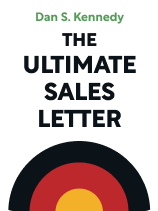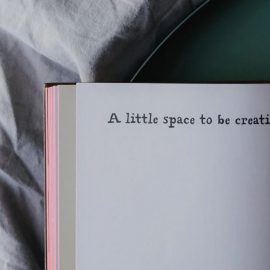

This article is an excerpt from the Shortform book guide to "The Ultimate Sales Letter" by Dan S. Kennedy. Shortform has the world's best summaries and analyses of books you should be reading.
Like this article? Sign up for a free trial here.
What are sales letters? Are they effective? How should one be written and used?
You don’t have to attend an elite institution to learn how to turn words into money, says multimillionaire entrepreneur Dan Kennedy in The Ultimate Sales Letter. Whether you’re a new business owner or just interested in writing persuasively, you can use Kennedy’s strategies to sell.
Continue reading to learn what a sales letter is, how to write a sales letter, and how to use a sales letter strategically.
What Is a Sales Letter?
Before addressing how to write a sales letter, let’s establish what a sales letter is. Since Kennedy doesn’t explicitly define one, further context may be useful. It’s a direct marketing tool designed to attract, build relationships with, and convince prospective consumers to buy your product. A low-cost alternative to television and other forms of advertising, sales letters are typically rooted in the “A.I.D.A.” formula (Attention, Interest, Desire, Action), and they’re often used by companies with smaller budgets or those that do “mail-order only” sales.
Kennedy focuses primarily on hard copy, long-form letters that were popular at the time of the book’s original publication in 1990—well before the rise of social media. However, more contemporary direct marketing tools, such as email and video sales letters, are rooted in the foundational elements Kennedy outlines.
The Ultimate Sales Letter is directed toward business owners and copywriters who are starting from scratch, though Kennedy asserts that seasoned professionals can use his tips and strategies as evergreen touchpoints and even learn a new thing or two.
How to Write a Sales Letter
Kennedy’s sales letter system can be presented as five steps. Let’s look at each one.
Step 1: Identify and Understand Your Target Customer
First, identify and understand your target customer so you can address their priorities and pitch your product in a way that resonates with them. Kennedy recommends that you narrow your focus to people who would buy your product. Determine their demographics, needs, fears, dreams, biases, and any history with a product like yours.
Step 2: Know Your Product
Become intimately acquainted with your product so you can highlight its benefits and address its weaknesses in your sales letter. Kennedy recommends that you get to know your product and how it operates by using it extensively. Identify your product’s best features and benefits, which you’ll prioritize and highlight for customers in your letter based on their distinct needs and interests.
you must also directly address its limitations in your sales letter to defuse customer concerns and keep them interested in buying your product. He recommends two strategies for countering questions that buyers may have about your product:
- Explain that you’ve conducted extensive research with consumers who didn’t buy your product, list every reason they gave for not buying, then address those issues.
- Present a list of frequently asked questions and answers about your product.
Kennedy suggests you bolster these strategies with testimonials, guarantees, and free trials.
Step 3: Write Your First Draft
Now that you have all the information you need about your customer and product, Kennedy says the first step of crafting your sales letter is to simply sit down and start writing. He notes that this step is intentionally brief since your goal is only to get your ideas on the page, not to worry about editing or getting things perfect.
| How to Draft a Sales Letter Kennedy doesn’t provide additional or explicit steps on how to write your first draft, but here’s a step-by-step outline you can use to draft a sales letter: Write a catchy headline that grabs your customer’s attention. Say why your product or service will benefit your customer. Provide key information about your product using bullet points. Provide testimonials or statistics to substantiate your product’s value. Provide a call to action (include a direct link or action button for online sales. For example: “Enter your email and website here, and we’ll send you free information on our product.”) Say that your product is available for a limited time, or is limited in its availability, to increase the urgency for customers to respond. Finish with a “PS” (postscript) where you offer a guarantee. |
Step 4: Grab, Engage, Convince, and Compel
Once you have a rough draft, you need to shape your letter so it grabs, engages, and convinces your customer to buy your product, then compels them to respond immediately.
Grab
Kennedy argues that your first goal in your letter is to quickly seize customers’ attention by telling them your product will solve an immediate problem. Failure to do this, he says, will result in your letter getting thrown away. Kennedy recommends the following tips to grab customers’ attention:
- Insert a headline at the top of your letter, following your initial greeting, that states a problem your target audience faces and the solution your product or service offers to fix it (for example: “Dear Ms. Hannigan: Give me 10 days and I’ll turn your hyperactive dog into your best-behaved friend!”).
- In your first paragraph, paint a vivid picture of your product using dramatic words, and describe the sights, smells, sounds, feel, and taste that buyers will experience while using it.
- Break traditional grammar rules in favor of unusual punctuation, buzzwords, and exclamations, which build energy.
- Keep sentences and paragraphs short (no more than four sentences per paragraph) to focus customers’ attention on key points.
Engage
Once you have your audience’s attention, you need to keep them engaged. Kennedy says you can do this by using a friendly, conversational tone, showing your personality, and repeating your sales pitch in as many different ways as possible. You can also encourage customer interaction by asking questions at the start or end of paragraphs and by writing partial sentences at the end of each page to force buyers to turn it over to find out what happens next.
| The Video Sales Letter—A Better Tool for Today? Kennedy recommends leading your letter with a headline—a brief span of text that grabs readers’ attention and hints at what you’re going to say next. This is a common approach in written and online sales letters because if your customer isn’t immediately interested in what you’re saying, they’ll stop reading. But some sales and marketing experts argue that an even more effective way to capture customers’ attention―and to keep them engaged and convince them they need your product right now—is to show your product in action using a video sales letter. Video sales letters are a visual marketing tool similar to written sales letters, but in video format. Proponents of this tool (over the written version) argue that video sales letters: • Allow you to use facial expressions, tone of voice, and background audio to quickly establish and maintain emotional connections with viewers. • Are better at engaging and convincing customers to buy your product The time it takes to watch them (typically two to three minutes) is shorter than what it would take to read a lengthy sales letter. Watching a person make a sales pitch feels more “real,” and is often more compelling and memorable than reading faceless words on a page. Psychologist Susan Weinschenck bolsters the idea that video sales letters are more effective than written sales letters, explaining that biology draws us to videos with people for four reasons: • Our brains are wired to look at human faces for information, believability, and emotion. • The tone of the human voice conveys meaning and context. • Emotions are contagious. • Motion grabs attention. If you want to write a video sales letter script that captivates, engages, and convinces customers to buy your product and compels them to respond quickly, experts say to create a hook, overcome buyers’ internal and external obstacles, and incentivize quick responses to your call to action. |
Convince
Once you’ve engaged your customer, you need to convince them that your product or service is valuable and worth the price. Kennedy says you shouldn’t worry about the length of your letter—take as many pages as you need to make a compelling argument.
Kennedy recommends providing evidence that highlights the benefits of your product or service to your customer, such as testimonials and photographs that show the product is easy to use or that your service delivers great results.
He also says you must address the tricky subject of your product’s price, which you have to navigate carefully because consumers won’t buy a product without knowing its price, but they’ll also forgo purchasing that product if they don’t like its price. He recommends two strategies to de-emphasize your product’s cost and turn customers’ focus to reasons they should buy it.
Strategy 1: Shift the conversation from your product’s price to the value or savings your customer will experience when they buy it:
- Pitch the quantity of your product—the bigger the better because people value bulk.
- Highlight the components that come with your product to create the appearance of additional value.
- Talk about the money and effort that went into producing your product to emphasize its quality.
- Advertise the monthly, not full, price of your product to make it look lower than it is.
- Tell customers that investing in your product will either save or make them more money in the long run than what they’ll spend upfront.
Strategy 2: Move beyond the topic of price by focusing on persuasion techniques that compel your customer to buy your product:
- Say that:
- You’re about to run out of your product.
- Smart people are buying your product (implication: If the consumer doesn’t buy it they’re not smart).
- Only special people understand the value of your product or have been selected to try it—and not everyone ticks these boxes.
- Paint a harrowing picture of a problem your target customer faces, provide an example that will trigger an emotional reaction in them, then say how your product will solve it.
- Repeatedly offer product guarantees (money back, refunds, free trials) or make them the central focus of your sales pitch.
Compel
After convincing your customer that they need your product, your goal is to get them to respond to your letter as quickly as possible. Kennedy says this is crucial because, when prospective customers put your letter down to “read it later,” they rarely do. He offers the following tips to compel consumers to respond to your letter immediately:
- Create a deadline by which customers have to respond to get your product.
- Offer incentives, such as premium package deals or discounts, for quick responses, or disincentives, like penalties, for slower responses.
- Provide multiple ways for consumers to respond to you (phone, email, standard mail with prepaid return mail option, even fax).
| Craft an Effective Call to Action (CTA) Kennedy provides suggestions for how to get buyers to respond quickly to your written sales letter. But if you’re looking to craft an effective online call to action (a prompt that encourages customers to respond to you by taking a specific action, like clicking a button to submit their email or buy your product), you can start with these five tips: • Place your CTA near the top of your web page. • Tell people what you want them to do and why (for example, “Subscribe now and you’ll get exclusive access to our best deals.” • Create a sense of urgency using action-oriented language (for example: “Sale ends tonight!”). • Keep your message simple. • Test different versions of your CTA to see what works best. |
Step 5: Refine, Finalize, and Send Your Letter
Now you have a letter that will capture your customer’s attention, convince them you have a product or service worth buying and compel them to respond quickly. Your last task is to put the finishing touches on your letter and make sure your target customer receives it. Kennedy recommends the following tips to polish your letter and make sure it gets into the right hands:
- Add a PS at the end of your letter where you make your pitch one last time.
- Edit your letter for clarity and cut words and phrases that don’t support and move your main point forward.
- Scan and tweak your letter for visual appeal, with an eye toward improving its readability. Emphasize key takeaways (and contact information) for customers using bold font, highlighting, or capital letters.
- Put your letter on trial:
- Read it out loud to see how it sounds.
- Read it to others for feedback on what’s effective, and what’s not.
- Compare it to similar letters to see how it stands up.
- Send yourself a copy to approximate customers’ experience receiving and reading it.
- Make final edits accordingly.
- Individualize its packaging: Use materials and packaging that appeal to different customers for the strongest possible chance of reaching your target customer.
- For executives and business owners: Use high-quality paper and envelopes, put your sales letter in a separate envelope from other materials you package it with, and use language that highlights the exclusivity of the product or services you’re selling.
- For mass mailings: Choose colorful, interactive materials.
- To prevent your letter from looking like junk mail that front-line mail sorters are likely to throw out, hand address a plain white envelope, don’t put a name in the return address, and opt for postage stamps instead of metered mail.
- Choose FedEx or first-class mail to prevent the postal service from filtering out your letter.
- Send your letter.
| Refine, Finalize, and Send a Video Sales Letter Kennedy’s fundamental processes for refining, finalizing, and getting your written sales letter to your target customer apply across contemporary sales mediums, but differences do exist—particularly when you compare written sales letters and video sales letters. For example, the process of editing a video sales letter requires different skills from editing a written letter. Also, with a written letter, you have to choose physical materials and send your letter by mail, but with a video sales letter, you have to publish and promote your video online. |
Use Your Sales Letter Strategically
Kennedy says that you can improve your brand recognition and increase customers’ response rate to your first sales letter by sending a second (and possibly third) follow-up letter 45 to 60 days after your first.
(Shortform note: Kennedy doesn’t provide specific information on what content should go in your follow-up letter. To get ideas and learn how to boost response rates to email sales letters, consider these templates for a series of follow-up emails. While the wording is important, the key is persistence—not quitting until you get a firm yes or no.)
Kennedy says that, in addition to using your sales letter to sell products and services to new and existing customers, you can also use it to:
- Identify qualified sales leads (people who’ve shown they’re interested in your product by responding to your call to action).
- Introduce and smooth the path for follow-up telemarketing calls.
- Bring foot traffic into your business (by announcing events and sales).
- Reduce product returns (by reinforcing that they made a good purchase).
Finally, Kennedy argues that, although social media has changed the communications landscape since the first publication of The Ultimate Sales Letter in 1990, the fundamentals required to write a powerful, long-form sales letter translate across platforms—including in online sales letters, TV infomercials, and other advertising. Because of their proven effectiveness, he asserts it would be foolish to abandon written copy sales letters and argues that a combination of offline and online sales letters is the best approach.
| The Combined Video Sales Strategy Kennedy asserts that a strategy combining written and online sales letters is the most effective, but he doesn’t explain why. Other proponents of the approach say it works because it allows you to reach a wider audience, build a stronger brand, reach customers at different points in the buying process, and save money on marketing. But, if a combination of written and online letters is more effective than either technique in isolation, then a combination of video sales strategies may be the best approach. Video commercials, 30- to 60-second ads, can supplement video sales letters by helping you attract customers, create and maintain awareness about your product, and build your brand. |
Exercise: Plan a Sales Letter
Kennedy says that writing a powerful sales letter starts with identifying and understanding your target audience, then getting to know your product inside and out.
- Think about the industry where a product that you want to sell is typically sold. Now think about where, in this industry, you could learn more about customers who might be interested in your product (this might be online resources, events you could attend, or people you could talk with).
- List three to five places where you could gather more information about prospective customers.
- Think about a specific product you want to sell. List three flaws with that product and the specific way you’d frame each problem with prospective customers.
- Think about Kennedy’s recommendations for addressing the price of your product with prospective customers. Describe three ways you’ll shift the conversation from price to value.

———End of Preview———
Like what you just read? Read the rest of the world's best book summary and analysis of Dan S. Kennedy's "The Ultimate Sales Letter" at Shortform.
Here's what you'll find in our full The Ultimate Sales Letter summary:
- How to craft powerful sales letters that will capture attention
- Time-tested foundational strategies in the art of persuasive writing
- Why you don't need a college degree to be a successful copywriter






